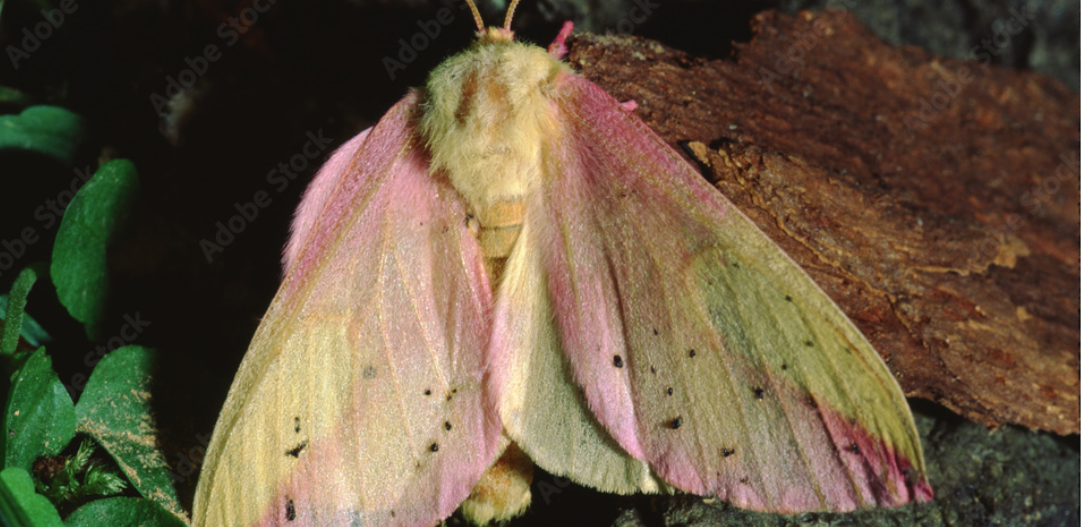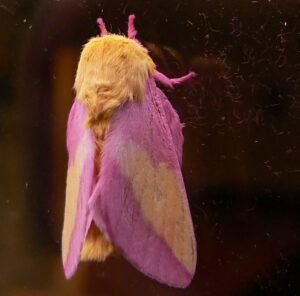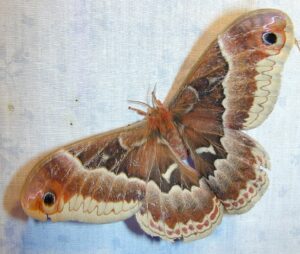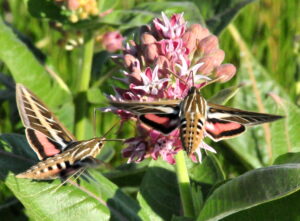
If you’ve ever left your porch light on at night or taken a walk through a blooming garden, you’ve likely seen a Lepidoptera or two. But what exactly is a Lepidoptera?
The term Lepidoptera combines two Greek words, “lepis” meaning scales and “ptero” meaning wings, and describes butterflies, skippers, and moths. Butterflies are often appreciated for their beautiful wings and vital role as pollinators, but their fuzzy nocturnal cousins, moths, deserve some love, too! In this blog we’ll be learning about three hawk moth (those are really big moths!) species that make their home right here in Indiana.
Meet the Moths!
Rosy Maple Moth (Dryocampa rubicunda)
The scientific name for the rosy maple moth combines the Greek words “dyro,” meaning oak tree, and “campa,” meaning caterpillar. Most adult rosy maple moths are yellow and pink, with an average wingspan of two inches or less.  Not only are these moths incredibly beautiful, but their coloration also acts as a form of camouflage, protecting them from predators by mimicking the winged seeds of red maple trees!
Not only are these moths incredibly beautiful, but their coloration also acts as a form of camouflage, protecting them from predators by mimicking the winged seeds of red maple trees!
(SOURCE:https://www.indiananature.net/pages/taxa/Animalia/d/Dryocampa_rubicunda.php )
Tulip-tree Silkmoth (Callosamia angulifera)
These moths are specialized feeders. Many scientists think they rely on Indiana’s state tree, the tulip tree, as their sole source of food.  Adult tulip-tree silkmoths have a wingspan of three to four inches, with distinct T-shaped spots present on each orange-brown wing. They also have two darker spots on their forewings called eyespots. By resembling the eyes of a larger, more dangerous creature these spots can scare off predators. (SOURCE:https://www.indiananature.net/pages/taxa/Animalia/c/Callosamia_angulifera.php )
Adult tulip-tree silkmoths have a wingspan of three to four inches, with distinct T-shaped spots present on each orange-brown wing. They also have two darker spots on their forewings called eyespots. By resembling the eyes of a larger, more dangerous creature these spots can scare off predators. (SOURCE:https://www.indiananature.net/pages/taxa/Animalia/c/Callosamia_angulifera.php )
White-lined Sphinx (Hyles lineata)
This species is one of the most abundant hawk moths found in North America! Adults have a wingspan of two to three inches, with grey-brown wings and distinctive white lines.  The underside of a female white-lined sphinx’s wings often has blush pink patches. These moths are commonly known as Hummingbird Moths because the way they feed on nectar resembles a hummingbird!
The underside of a female white-lined sphinx’s wings often has blush pink patches. These moths are commonly known as Hummingbird Moths because the way they feed on nectar resembles a hummingbird!
Not only are these moths just as beautiful and unique as your favorite winged insect, but they also play a vital role in the environment, too! When all the other pollinators have retired for the night, these lovely Lepidoptera are there to pick up the slack, pollinating more plants at night than bees do during the day! Next time you see one of our fuzzy friends, we hope you’ll appreciate the beauty of moths!
